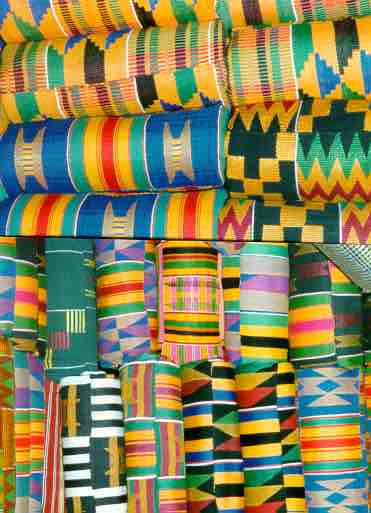Background: The Asante People and Akan Art
The Asante, or Ashanti, are a nation and ethnic group who live predominantly in and are native to Ashanti, Asanteman, and in Ghana and the Ivory Coast. They speak Asante and are of Akan origin. Prior to European colonization, the Ashanti people developed a large and influential empire in West Africa. The Ashanti later developed the powerful Ashanti Confederacy, or Asanteman, and became the dominant presence in the region. The Asantehene is the political and spiritual head of the Asantes.
Art from the Akan people of West Africa is known primarily for Akan goldweights and cultural jewelry. The Akan people are also known for their strong connection between visual and verbal expressions. Akan culture values gold above all other metals, so the artwork and jewelry made of gold is of great worth to them, whether it be made for appearance, artistic expression, or more practical trading purposes.
Kente Cloth
Kente cloth (known as Nwentom in the Asante language), is an Asante type of silk and cotton fabric made of interwoven cloth strips that is native to the Asante people. The cloth was traditionally a royal and sacred cloth worn only at times of high importance, most often by Asante emperors-kings. Over time, the use of the Kente became more widespread; however, its importance has remained and it is held in high esteem among the Asante people.
Kente cloth is made in Kumasi, the capital of Asante, and in the Asanteland Peninsula (specifically in Bonwire, Adanwomase, Sakora Wonoo, and Ntonso in the Kwabre areas of the Asante). The cloth is also worn by many other groups who have been influenced by Asante people, making it one of the best known of all African textiles.
Traditions and Development
A variety of Kente patterns have been invented, each of which has a certain concept or concepts traditionally associated with it. For example, the Obaakofoo Mmu Man pattern symbolizes democratic rule; Emaa Da symbolizes novel creativity and knowledge from experience; and Sika Fre Mogya represents responsibility to share monetary success with one's relations. According to legend, Kente was first made by two Asante friends who went hunting in a forest and found a spider making its web. The friends stood and watched the spider for two days before returning home to implement what they had seen. West Africa has had a cloth weaving culture for centuries via the stripweave method, but Asante history tells of the cloth being created independent of outsider influence.
Uses
The icon of African cultural heritage around the world, Kente cloth is identified by its dazzling, multicolored patterns of bright colors, geometric shapes, and bold designs. A Kente cloth is typically sewn together from many narrow (about 3.9 inches wide) kente stripes. Cloth that is characterized by weft designs woven into every available block of plain weave is called adweneasa. The Asante people choose Kente cloths as much for their names as for their colors and patterns; although the cloths are identified primarily by the patterns found in the lengthwise (warp) threads, there is often little correlation between appearance and name. Names are derived from several sources, including proverbs, historical events, important chiefs, queen mothers, and plants.

Kent cloth
Kente weaving is a traditional craft among the Asante people of Ghana. A kente cloth is typically sewn together from many narrow (about 3.9 inches wide) kente stripes. This image shows different patterns of typical Asante Kente stripes.